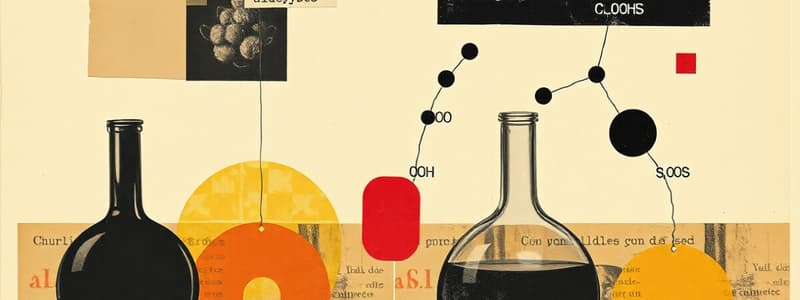Podcast
Questions and Answers
Which reaction product forms from the reduction of an aldehyde or ketone with hydride ion?
Which reaction product forms from the reduction of an aldehyde or ketone with hydride ion?
- Carboxylic acid
- Imine
- Alcohol (correct)
- Primary amine
The hydrolysis of imines is a reversible process.
The hydrolysis of imines is a reversible process.
False (B)
What type of compound is formed when an aldehyde reacts with a primary amine?
What type of compound is formed when an aldehyde reacts with a primary amine?
Imine
The unstable imine formed from ammonia is ________ to yield an amine.
The unstable imine formed from ammonia is ________ to yield an amine.
Match the following reactions with their respective products:
Match the following reactions with their respective products:
Which of the following describes a ketone?
Which of the following describes a ketone?
Aldehydes are less reactive than ketones due to steric hindrance.
Aldehydes are less reactive than ketones due to steric hindrance.
What causes the aldehyde to be more reactive than a ketone?
What causes the aldehyde to be more reactive than a ketone?
Aldehydes and ketones are _______ reactive than esters.
Aldehydes and ketones are _______ reactive than esters.
Match the following terms to their definitions:
Match the following terms to their definitions:
What type of reaction do aldehydes and ketones typically undergo?
What type of reaction do aldehydes and ketones typically undergo?
The carbonyl carbon in cyclic ketones is assumed to be at the 2-position.
The carbonyl carbon in cyclic ketones is assumed to be at the 2-position.
In terms of reactivity, aldehydes and ketones are _______ reactive than carboxylate ions.
In terms of reactivity, aldehydes and ketones are _______ reactive than carboxylate ions.
What is the main difference in the reaction of carboxylic acid derivatives compared to aldehydes and ketones?
What is the main difference in the reaction of carboxylic acid derivatives compared to aldehydes and ketones?
Grignard reagents are strong acids that react with water.
Grignard reagents are strong acids that react with water.
What do Grignard reagents form when they react with carbon dioxide?
What do Grignard reagents form when they react with carbon dioxide?
In the reaction mechanism of aldehydes or ketones with a Grignard reagent, addition of __________ breaks up the complex.
In the reaction mechanism of aldehydes or ketones with a Grignard reagent, addition of __________ breaks up the complex.
Match the following compounds with their products when reacted with Grignard reagents:
Match the following compounds with their products when reacted with Grignard reagents:
What kind of mixture is produced when a Grignard reagent reacts with a carbonyl compound that has an asymmetric center?
What kind of mixture is produced when a Grignard reagent reacts with a carbonyl compound that has an asymmetric center?
Direct addition products are formed when strong bases react with aldehydes and ketones.
Direct addition products are formed when strong bases react with aldehydes and ketones.
What happens to the complex formed when a Grignard reagent reacts with an aldehyde or ketone?
What happens to the complex formed when a Grignard reagent reacts with an aldehyde or ketone?
Flashcards
Formaldehyde
Formaldehyde
A carbonyl containing compound with two hydrogens attached to the carbonyl carbon.
Aldehyde
Aldehyde
A carbonyl containing compound with one hydrogen and at least one alkyl group attached to the carbonyl carbon.
Ketone
Ketone
A carbonyl containing compound with two alkyl groups attached to the carbonyl carbon.
Reactivity of aldehydes and ketones
Reactivity of aldehydes and ketones
Signup and view all the flashcards
Why aldehydes are more reactive than ketones (Electronic reason)
Why aldehydes are more reactive than ketones (Electronic reason)
Signup and view all the flashcards
Why aldehydes are more reactive than ketones (Steric reason)
Why aldehydes are more reactive than ketones (Steric reason)
Signup and view all the flashcards
Nucleophilic attack on aldehydes and ketones
Nucleophilic attack on aldehydes and ketones
Signup and view all the flashcards
Where do nucleophiles attack?
Where do nucleophiles attack?
Signup and view all the flashcards
Ester + Hydride Ion
Ester + Hydride Ion
Signup and view all the flashcards
Carboxylic Acid + Hydride Ion
Carboxylic Acid + Hydride Ion
Signup and view all the flashcards
Amides + Hydride Ion
Amides + Hydride Ion
Signup and view all the flashcards
Aldehyde/Ketone + Cyanide Ion
Aldehyde/Ketone + Cyanide Ion
Signup and view all the flashcards
Cyanohydrin Reactions
Cyanohydrin Reactions
Signup and view all the flashcards
What are Grignard reagents?
What are Grignard reagents?
Signup and view all the flashcards
How do Grignard reagents react with carbonyls?
How do Grignard reagents react with carbonyls?
Signup and view all the flashcards
How do Grignard reagents make alcohols?
How do Grignard reagents make alcohols?
Signup and view all the flashcards
How do Grignard reagents make carboxylic acids?
How do Grignard reagents make carboxylic acids?
Signup and view all the flashcards
What are the products from Grignard reactions with esters and acyl chlorides?
What are the products from Grignard reactions with esters and acyl chlorides?
Signup and view all the flashcards
How do aldehydes and ketones react with strong bases?
How do aldehydes and ketones react with strong bases?
Signup and view all the flashcards
What happens when acyl chlorides react with hydride ion (H-)?
What happens when acyl chlorides react with hydride ion (H-)?
Signup and view all the flashcards
What happens when esters react with hydride ion (H-)?
What happens when esters react with hydride ion (H-)?
Signup and view all the flashcards
Study Notes
Chapter 12: Reactions of Aldehydes and Ketones
- This chapter discusses reactions of aldehydes and ketones, extending the study of carboxylic acid derivatives.
- The chapter continues the discussion of families of compounds in Group IV.
- Group IV compounds are characterized by a central atom (C) with shared electrons with other atoms.
- Aldehydes and ketones are carbonyl compounds based on their functional group.
- Carbonyl compounds are characterized by a carbon atom double-bonded to an oxygen atom.
- Carbonyl compounds contain hydrogen and alkyl groups.
- Formaldehyde has two hydrogen atoms.
- Aldehyde has one hydrogen and one alkyl group.
- Ketone has two alkyl groups.
Examples of Aldehydes and Ketones in Nature
- Vanillin is a vanilla flavoring, an aldehyde.
- Cinnamaldehyde has a cinnamon flavor, an aldehyde.
- Camphor is a ketone.
- (R)-(-)-carvone is found in spearmint oil, a ketone.
- (S)-(+)-carvone is found in caraway seed oil, a ketone.
Biologically Important Ketones
- Progesterone is a ketone with biological importance.
- Testosterone is a ketone with biological importance.
Naming Aldehydes
- Systematic and common names are used for aldehydes.
- Examples include methanal (formaldehyde), ethanal (acetaldehyde), 2-bromopropanal (α-bromopropionaldehyde), 3-chlorobutanal (β-chlorobutyraldehyde), and 3-methylbutanal (isovaleraldehyde), hexanedial.
Naming Ketones
- Systematic and common names are used for ketones.
- Examples include propanone (acetone), 3-hexanone, ethyl propyl ketone, 6-methyl-2-heptanone, isohexyl methyl ketone, cyclohexanone, butanedione, 2,4-pentanedione (acetylacetone).
Aldehydes and Ketones are Attacked By Nucleophiles
- The carbonyl carbon, with a partial positive charge, is susceptible to nucleophilic attack.
Aldehydes Are More Reactive Than Ketones
- Aldehydes have a higher partial positive charge on their carbonyl carbon because hydrogen is more electron-withdrawing than an alkyl group.
- Aldehydes are more accessible to a nucleophile than ketones due to sterics.
Aldehydes and Ketones Are Moderately Reactive Carbonyl Compounds
- These compounds are less reactive than acyl halides and acid anhydrides but more reactive than esters, carboxylic acids, amides, and carboxylate ions.
Aldehydes and Ketones React Differently Than Carboxylic Acid Derivatives
- In carboxylic acid derivatives, a Y group can be replaced.
- Nucleophilic acyl substitution is observed in carboxylic acid derivatives.
- In aldehydes and ketones, alkyl and hydride groups cannot leave.
- Nucleophilic addition is observed instead.
Organometallic Compounds
- Organometallic compounds react with electrophiles or nucleophiles, depending on the electronegativity.
- In organometallic compounds, less electronegative atoms are nucleophiles, and more electronegative atoms are electrophiles.
Organometallic Compounds: Grignard Reagents
- Grignard reagents act as carbanions.
- Grignard reagents react vigorously with water.
Mechanism for the Reaction of an Aldehyde or a Ketone with a Grignard Reagent
- Grignard reagents react with aldehydes, ketones, and carboxylic acid derivatives.
- Addition of dilute acid breaks down the complex product.
Grignard Reagents Are Used to Prepare Alcohols
- Grignard reagents can be used to synthesize primary, secondary, or tertiary alcohols.
Grignard Reagents Form Carboxylic Acids by Reaction with Carbon Dioxide
- The carboxylic acid product has one more carbon than the Grignard reagent.
Reaction Examples with Grignard Reagents
- The acid should be added after the Grignard reaction with the carbonyl compound for correct product formation.
- A reaction with an asymmetric center with a reactant without an asymmetric center results in a racemic mixture.
Esters React with Grignard Reagents to Form Alcohols
- Esters react with Grignard reagents to form alcohols through nucleophilic addition-elimination reactions.
Acyl Chlorides React with Grignard Reagents to Form Alcohols
Reactions of Aldehydes and Ketones with Hydride Ion
- Hydride ion reacts with aldehydes and ketones to form alcohols (primary, secondary).
Strong Bases Form Direct Addition Product
- Strong bases undergo direct addition reactions.
Reactions of Acyl Chlorides with Hydride Ion
- This reaction forms an aldehyde by nucleophilic addition-elimination.
Reaction of an Ester with Hydride Ion
- Hydride ion reacts with an ester to form a primary alcohol and an alcohol.
Mechanism for the Reaction of an Ester with Hydride Ion
- A nucleophilic addition-elimination reaction forms the product by removing a group from an intermediate tetrahedral carbon followed by protonation.
Reactions of Carboxylic Acids with Hydride Ion
- The reaction between an acid and a hydride ion produces an alcohol.
The Reactions of Amides with Hydride Ion
- Amides react with hydride ions to produce primary or secondary amines.
Reaction of Aldehydes and Ketones with Cyanide Ion
- Aldehydes and ketones react with cyanide ions to form cyanohydrins.
Reactions of Cyanohydrins
- Cyanohydrins undergo hydrolysis to form α-hydroxycarboxylic acids.
- Cyanohydrins can also be reduced to primary amines.
Aldehydes and Ketones Form Imines with Primary Amines
- Aldehydes and ketones form imines with primary amines through reactions with removal of water.
Imine Hydrolysis is Irreversible
- Imine hydrolysis, occurring in acidic conditions, is irreversible due to amine protonation.
Reductive Amination
- Ammonia reduction produces an unstable imine followed by hydrogenation to form primary amines.
The Reaction of an Aldehyde or Ketone with an Alcohol
- Aldehydes and ketones with alcohols form hemiacetals and acetals.
Acid-Catalyzed Hydrolysis of an Acetal
- Excess water reacts with an acetal in acidic conditions to yield a carbonyl compound and two alcohol molecules.
Studying That Suits You
Use AI to generate personalized quizzes and flashcards to suit your learning preferences.




